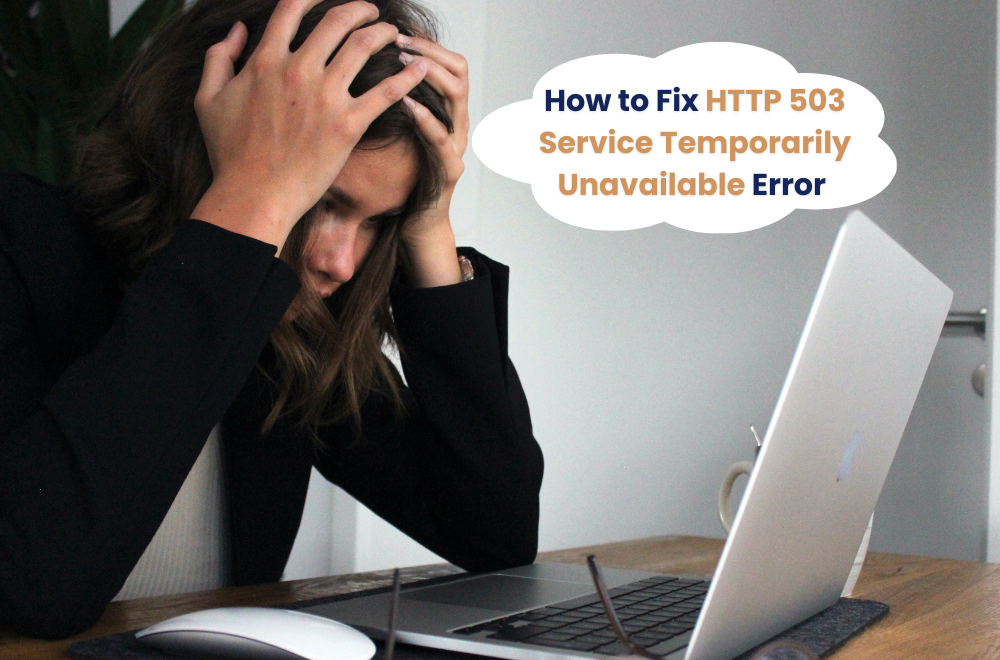
When it comes to web browsing, users expect seamless access to websites. However, sometimes, instead of the webpage, they encounter a blank screen with an HTTP 503 service temporarily unavailable error.
If you are running an online business, maintaining a high uptime and a stable website is your utmost priority, and 5xx errors can negatively impact your business.
Errors like HTTP 503 service temporarily unavailable can spoil the user experience and hurt the website’s credibility. To help you fix the dreaded 503 error, we came up with this comprehensive guide in which we’ll explore the 503 error in detail, including its causes and how you can fix it.
Understanding HTTP Error 503
Before we dive headfirst into the solutions, let’s briefly understand what HTTP Error 503 actually means. It’s like deciphering a secret code! So, what’s the scoop?
What Is 503 Service Unavailable?
The 503 service temporarily unavailable error is a server-side HTTP error code. HTTP status codes are used by web browsers and web servers to communicate when a user is accessing the internet. Your web browser makes queries to the web server hosting the website’s content each time you view a certain page. After retrieving the requested resources, the web server replies with an HTTP response status code that denotes whether the request was successful or unsuccessful.
The 503 service temporarily unavailable error belongs to the 5xx series of HTTP status codes, specifically indicating a server-side error. Unlike client-side errors (4xx), server-side errors like 503 imply that the server can’t currently handle the request. Here are some variations you might encounter based on your server configuration and browser:
- 503 Service Unavailable
- 503 Service Temporarily Unavailable
- HTTP Server Error 503
- HTTP Error 503
- Error 503 Service Unavailable
| Error code | 503 service unavailable error |
| Error type | Server-side error |
| Error variations | HTTP Error 503. The service is unavailable. |
| 503 Service Unavailable | |
| Error 503 Service Unavailable | |
| 503 Service Temporarily Unavailable | |
| HTTP Error 503 | |
| HTTPS Error 503 | |
| HTTP Server Error 503 | |
| The server is temporarily unable to service your request due to maintenance downtime or capacity problems. Please try again later. |
Opting for a reliable hosting service can avoid the 503 errors. WPProvider offers stable and fast hosting services for your wordpress and email hosting needs to minimize downtime.
Now, let’s roll up our sleeves and tackle this issue!
Diagnosing the Culprit
Before you start fiddling with your server settings, it’s important to identify the root cause of the HTTP status code 503. Like a detective solving a mystery, you need to gather clues! Here’s how:
Check Server Logs
- Dive into your server logs. These logs are like the server’s diary, containing information about what’s going on.
- Look for error messages or warnings that might shed light on the problem.
- Pay attention to timestamps – they can help you pinpoint when the issue started.
Review Recent Changes
- Have you made any recent changes to your server or website configuration?
- Updates, software installations, or changes in server settings can sometimes trigger the error.
- Roll back any recent changes if you suspect they are the culprits.
Test Other Websites
- Is the problem isolated to your website, or are other websites affected as well?
- Try accessing other domains to see if the issue is more widespread.
- If it’s only your website, the problem likely lies on your server.
Server Resource Check
- Examine the server’s resource utilization, including CPU, RAM, and disk space.
- An overloaded server can often result in an HTTP Error 503.
- Consider optimizing your server or upgrading its resources.
Common Causes of the 503 service temporarily unavailable error
Resource Bottleneck
- When a web server’s resources, such as RAM, CPU, I/O, entry processes, and inodes, are fully utilized, it can result in a 503 error. Monitoring these metrics can help identify resource-related issues.
Server Communication Problems
- Network connectivity problems, server misconfigurations, or issues with server communication can lead to the 503 error.
Sudden Traffic Spikes
- A surge in web traffic can overwhelm the server, causing it to be unable to handle the increased load.
Distributed Denial of Service (DDoS) Attack
- Malicious attempts to flood a website with traffic can lead to a 503 error, as the server struggles to manage the excessive requests.
Incorrect DNS Configuration
- Misconfigured DNS settings can prevent the server from resolving domain names to IP addresses correctly, resulting in service unavailability.
Plugin or Theme Incompatibility
- Incompatibility issues with plugins or themes on content management systems like WordPress can also trigger the 503 error.
Solutions to Fix HTTP 503 Response Code
Now that you’ve known how to identify the root cause of error 503, it’s time to explore the solutions. These are your secret tools to resolve the HTTP status code 503!
Restart Your Server
Ah, the classic “turn it off and on again” trick – it works wonders!
- A simple server restart can resolve temporary issues caused by an overloaded server or minor configuration glitches.
- Access your server control panel and initiate a graceful restart.
Server Maintenance
Check if your server is undergoing maintenance. The best thing you can do is:
- Be patient! Maintenance periods are usually temporary.
- Check the status page of your hosting provider for updates on when your server will be back online.
- Inform your website visitors about the maintenance schedule to manage expectations.
Load Balancing
Load balancing distributes the load evenly across multiple servers, preventing overload issues.
- Implement load balancing if you expect your website to have high traffic regularly.
- It’s a bit advanced, so consult with your hosting provider or a server expert to set it up correctly.
Stop Running Processes
Sometimes, certain processes can overload the server, causing a 503 error.
- Identify and terminate processes that are overloading the server’s capacity.
- Investigate plugins and themes for resource-intensive components.
Review Server Configuration
It’s time to dive into the nitty-gritty of server settings.
- Check your web server’s configuration files (e.g., Apache, Nginx) for errors.
- Ensure that your server has ideal resources to handle the incoming traffic.
- Correct any misconfigurations or resource allocation issues.
Database Optimization
Your website’s database can be a major bottleneck. You can optimize it by:
- Checking for slow-running database queries that might be clogging up your server.
- Index your database tables to speed up query performance.
- Consider implementing caching mechanisms to reduce database load.
Content Delivery Network (CDN)
CDN improves the stability of your website by reducing the latency of your website by adding middle servers between your main server and the client:
- Utilize a CDN service to distribute your website’s content to multiple servers worldwide.
- This reduces the load on your primary server and enhances user experience.
- Popular CDN providers include Cloudflare, Akamai, and Amazon CloudFront.
Check Your DNS
Sometimes, your DNS can be the reason behind the 503 error. Follow these tips to resolve any DNS errors.
- Flush the DNS cache to resolve DNS-related issues.
- Consider switching to public DNS servers if problems persist.
Increase Your Server Resources
- If your website crashes frequently, it may be time to upgrade your server resources.
- Upgrading the resources improves the stability and performance of your website and allows it to handle more requests.
- Increasing your server resources can also speed up your website.
Conclusion
Keep in mind that the longer a 503 error is displayed on your website, the more potential customers you risk losing. React quickly to fix errors, protect your brand’s image, and guarantee a flawless customer experience.
By addressing the specific causes of the 503 Service Unavailable Error and following these guidelines, you can swiftly resolve the issue, prevent visitor frustration, and maintain your website’s integrity and trustworthiness.
Contact us today to get a fast and reliable managed WordPress hosting service with minimal downtime.




